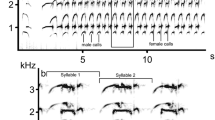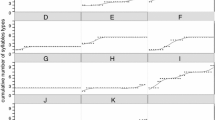Abstract
Acoustic-based monitoring has proved useful for many birds and seems promising for the endangered red-crowned crane. However, its validity in crane conservation is unclear in the absence of knowledge concerning the long-term stability of pair-specific duets. The red-crowned crane is monogamous and long-lived, with stable pair bonding both within and between years. Pair mates perform loud duets—a succession of male and female calls emitted with definite temporal coordination. We examined the stability of duets for five captive pairs over five years (2003–2007) on the basis of analysis of the syllables within the duets. MANOVA showed that the effect of pair identity on syllable characteristics was always stronger than the effect of the year of recording. Cross-validation of duets from 2004, 2005, 2006, and 2007 with discriminant analysis (DFA) functions derived, respectively, from pooled samples from 2003, 2003–2004, 2003–2005, and 2003–2006 resulted in comparably high percentages of correct classification into pairs. The pairs could be reliably identified by their duets and pair-specific differences in syllable characteristics were stable with time. These data suggest acoustic monitoring is a feasible alternative to more invasive methods of identification.


Similar content being viewed by others
References
Andronov VA (1988) Current population size of red-crowned and white-naped cranes in Amur region. In: Litvinenko N, Neitfeld I (eds) Cranes of Palearctic. Vladivostok, Academia nauk USSR, pp 187–190 (in Russian)
Andronov VA, Rozdina O (2002) About new project of red-crowned cranes release in the wild. Newsl Crane Work Group Eurasia 4–5:60–62
Andronova RS, Andronov VA (2005) Reintroduction of the red-crowned crane and the white-naped crane in the south of the far east. In: Winter S, Ilyashenko E (eds) Cranes of Eurasia (biology, protection, breeding in captivity) 2. Moscow, Moscow Zoo, pp 187–202 (in Russian)
Archibald GW (1976) The unison call of cranes as a useful taxonomic tool. PhD thesis, Cornell University, Ithaca
Archibald GW (2000) The status of the worlds endangered cranes—Year 2000 Report of Crane Specialist Group. In: Salvi A (ed) Proceedings of the 4th European Crane Workshop 2000, Fenetrange, France, November 2000, pp 242–245
Archibald GW, Lewis JC (1996) Crane biology. In: Ellis DH, Gee GF, Mirande CM (eds) Cranes: their biology, husbandry, and conservation. International Crane Foundation (ICF), Baraboo, pp 1–31
Budde C (2001) Individual features in the calls of the grey crowned crane Balearica regulorum gibbericeps. Ostrich 72(384):134–139
Delport W, Kemp AC, Ferguson WH (2002) Vocal identification of individual African wood owls Strix woodfordii: a technique to monitor long-term adult turnover and residency. Ibis 144:30–39
Eakle WL, Mannan RW, Grubb TG (1989) Identification of individual breeding bald eagles by voice analysis. J Wildl Manage 53:450–455
Galeotti P, Sacchi R (2001) Turnover of territorial scops owls Otus scops as estimated by spectrographic analyses of male hoots. J Avian Biol 32:256–262
Gilbert G, McGregor PK, Tyler G (1994) Vocal individuality as a census tool: practical considerations illustrated by a study of two rare species. J Field Ornithol 65:335–348
Gilbert G, Tyler GA, Smith KW (2002) Local annual survival of booming male great bittern Botaurus stellaris in Britain, in the period 1990–1999. Ibis 144:51–61
Guyomarc’h J-C, Aupiais A, Guyomarc’h C (1998) Individual differences in the long-distance vocalizations used during pair bonding in European quail (Coturnix coturnix). Ethol Ecol Evol 10:333–346
IUCN (2004): 2006 IUCN Red List of threatened species [online]. http://www.iucnredlist.org/
Kamata M (1994) Family breakup of the red-crowned crane Grus japonensis at an artificial feeding site in eastern Hokkaido, Japan. In: Higuchi H, Minton J (eds) The Future of cranes and wetlands. Wild Bird Society of Japan, Tokyo, pp 149–155
Kitagawa T (1982) Bionomics and sociology of Tancho, Grus japonensis III. Territoriality. J Yamashina Inst Orn 14(2/3):344–362
Klenova AV, Volodin IA, Volodina EV (2008) The duet structure provides information about pair identity in the red-crowned crane (Grus japonensis). J Ethol 26:317–325
Lengagne T (2001) Temporal stability in the individual features in the calls of eagle owls (Bubo bubo). Behaviour 138:1407–1419
Masatomi H (2000) Present status of Tancho (red-crowned crane, Grus japonensis) in Japan. In: Salvi A (ed) Proceedings of the 4th European Crane Workshop 2000, Fenetrange, France, November 2000, pp 267–274
Menu S, Hestbeck JB, Gauthier G, Reed A (2000) Effects of neck bands on survival of greater snow geese. J Wildl Manage 64:544–552
Naguib M, Wiley RH (2001) Estimating the distance to a source of sound: mechanisms and adaptations for long-range communication. Anim Behav 62:825–837
Parilov MP (2002) The 2002 field season in Khingansky State Nature Reserve. Newsl Crane Work Group Eurasia 4–5:36–37
Puglisi L, Adamo C (2004) Discrimination of individual voices in male great bitterns (Botaurus stellaris) in Italy. Auk 121:541–547
Schmutz JA, Morse JA (2000) Effects of neck collars and radiotransmitters on survival and reproduction of emperor geese. J Wildl Manage 64:231–237
Terry AMR, Peake TM, McGregor PK (2005) The role of vocal individuality in conservation. Front Zool 2:1–16
Tripp TM, Otter KA (2006) Vocal individuality as a potential long-term monitoring tool for western screech-owls Megascops kennicottii. Can J Zool 84:744–753
Viniter S (1981) Nesting of the red-crowned crane in the central Amur region. In: Lewis JC, Masatomi H (eds) Crane research around the world. International Crane Foundation (ICF), Baraboo, pp 74–80
Volodin IA, Klenova AV, Volodina EV (2008) Modeling bioacoustical monitoring through years with captive population of the red-breasted goose. Casarca (Bull Goose Swan Duck Study Group North Eurasia) 11:22–46
Walcott C, Mager JN, Piper W (2006) Changing territories, changing tunes: male loons, Gavia immer, change their vocalizations when they change territories. Anim Behav 71:673–683
Wessling B (2000) Individual recognition of cranes by sonography. In: Salvi A (ed) Proceedings of the 4th European crane workshop 2000, Fenetrange, France, pp 134–149
Acknowledgments
We thank the staff of the Oka Crane Breeding Centre of Oka Biosphere State Nature Reserve, and personally T.A. Kashentseva, K.A. Postelnykh, T.V. Postelnykh, and E.V. Antonyuk, for making this research possible and for all-round help during data gathering. Also, we thank E.V. Bragina for help with duet recordings and O.A. Filatova for help with data treatment. We are sincerely grateful to Tomasz Osiejuk whose comments were useful and constructive. Finally, we thank two anonymous reviewers, whose comments helped to improve the text thoroughly. During our work, we adhered to the Guidelines for the Use of Animals in Research (Animal Behaviour, 2006, 71: 245–253) and to the laws of Russian Federation, the country where the research was conducted. This study was supported by the Russian Foundation for Basic Research (grant 06-04-48400).
Author information
Authors and Affiliations
Corresponding author
About this article
Cite this article
Klenova, A.V., Volodin, I.A. & Volodina, E.V. Examination of pair-duet stability to promote long-term monitoring of the endangered red-crowned crane (Grus japonensis). J Ethol 27, 401–406 (2009). https://doi.org/10.1007/s10164-008-0133-9
Received:
Accepted:
Published:
Issue Date:
DOI: https://doi.org/10.1007/s10164-008-0133-9




